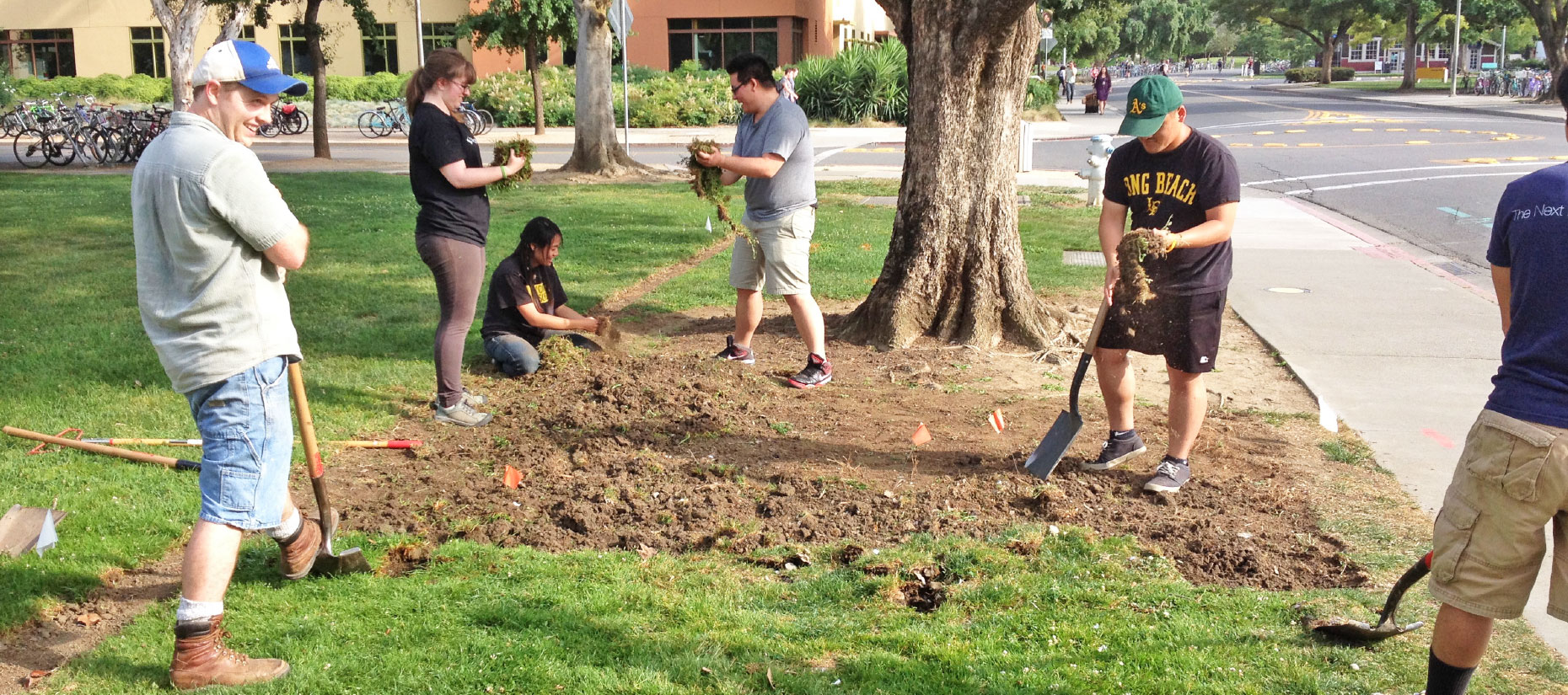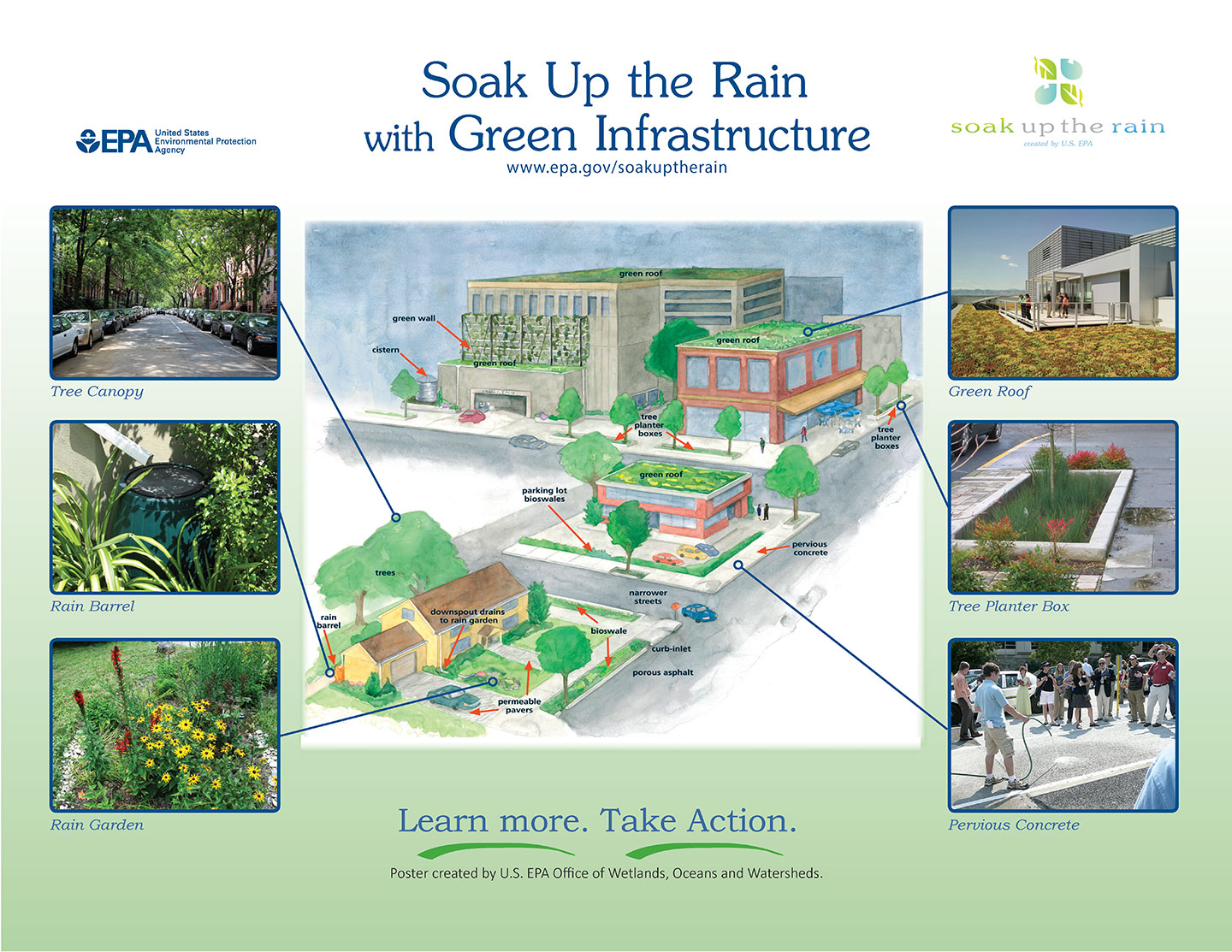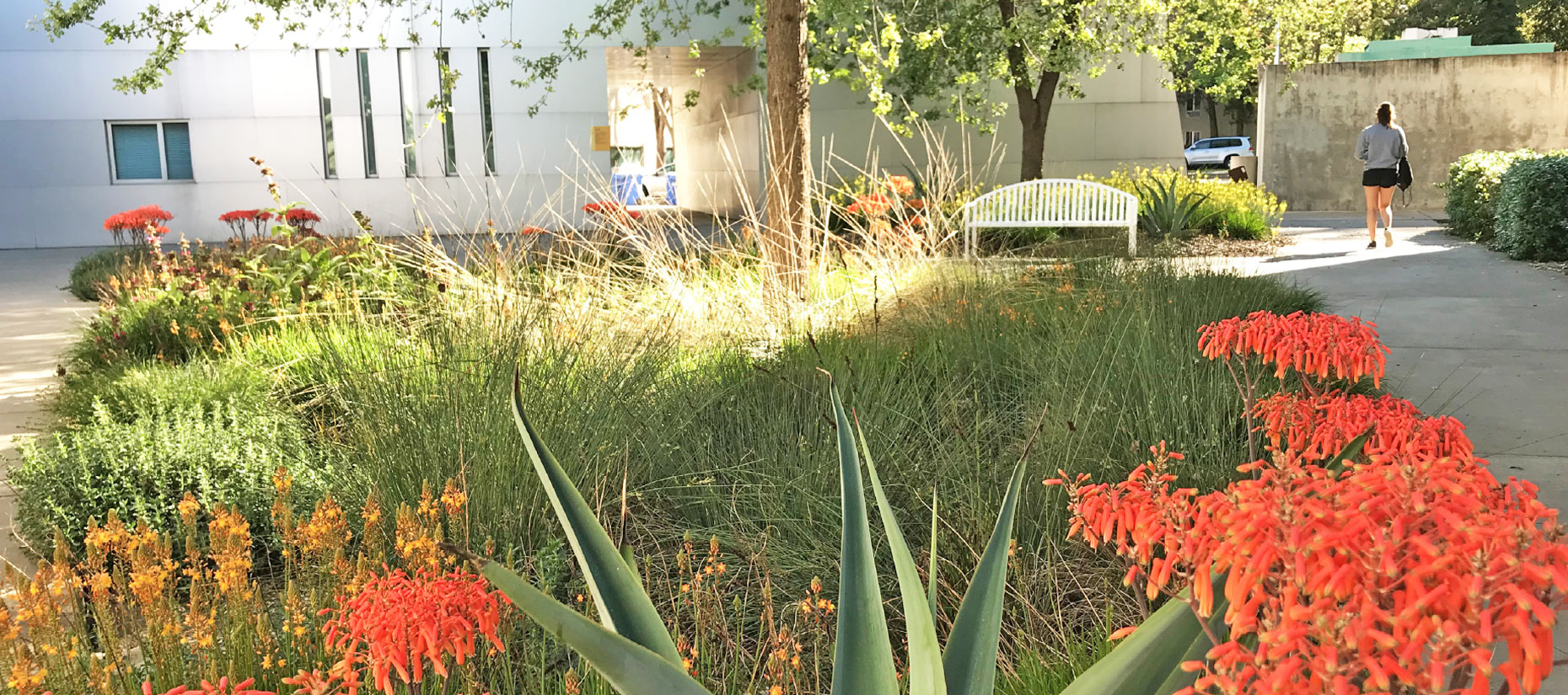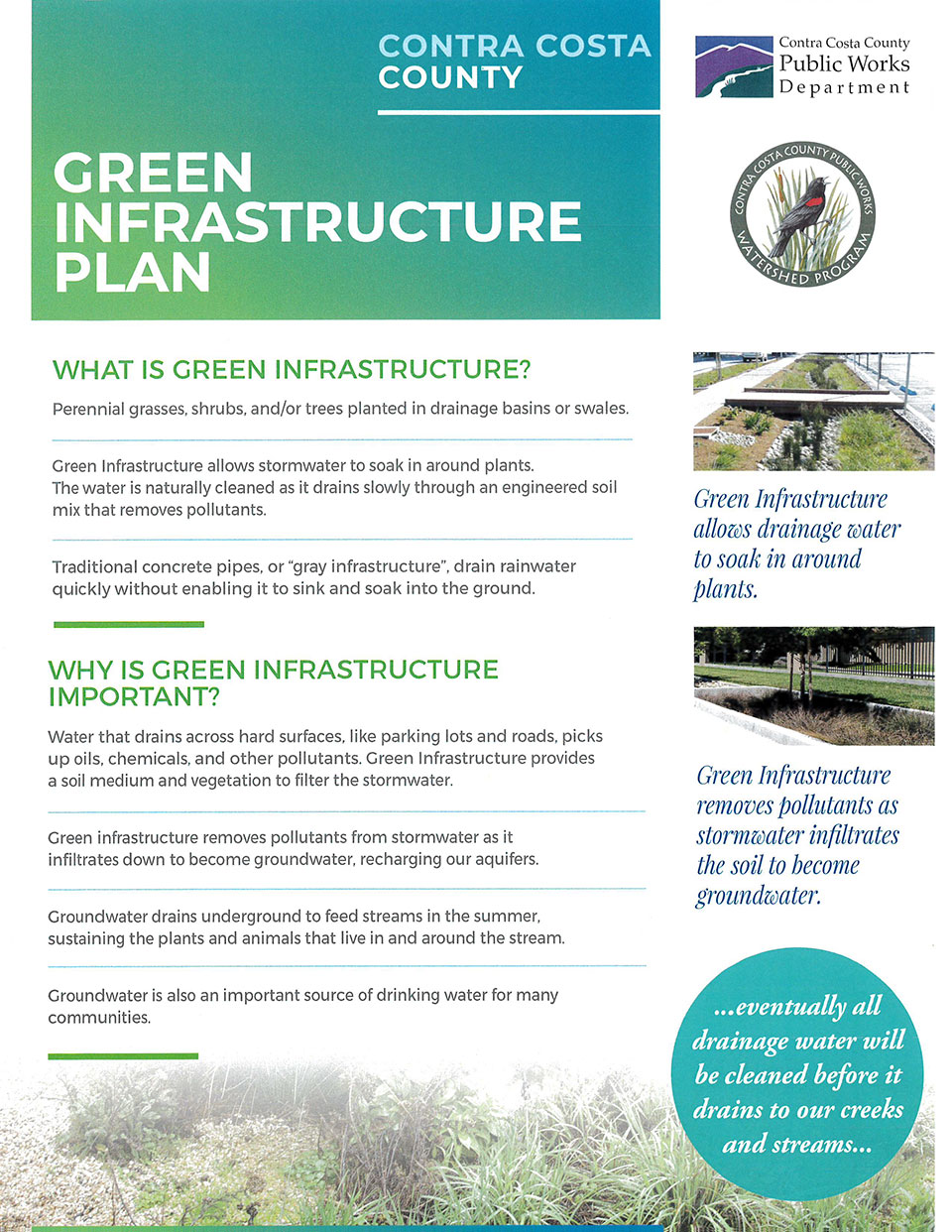Green Infrastructure
Contra Costa County
Contra Costa County has developed a Green Infrastructure (GI) Plan for implementation over the next 20 years that will identify locations where GI can be installed. The projects are located on County owned property or along County roads and are aimed at cleaning stormwater before it drains to the County’s creeks and streams that flow into the Delta and the San Francisco Bay.

PHOTO: Kevin Perry FASLA, Urban Rain Design, Inc., example of Tactical Green Infrastructure
What is Green Infrastructure?
Green Infrastructure techniques are sustainable solutions that help to minimize pollution and its environmental impact in urban areas. These techniques may include rain water harvesting, bioswales, rain gardens, downspout planters, green roofs, permeable paving, and enhanced tree pits.
Environmental Benefits
Green infrastructure is a critical component of sustainable urban communities. Its benefits include air quality regulation, erosion management and protection, support of manageable water runoff and aquifer recharge, preservation of pollinator habitats, maintenance of soil structure and quality, purification of water, and contributes to healthy climate regulation at the global level.
Community Benefits
Green infrastructure benefits communities in a number of important ways. As well as being a cost-effective and resilient approach to water infrastructure, implementation of green infrastructure in neighborhoods and common areas of the community provides residents with emotional and physical health benefits, opportunities to enjoy outdoor living spaces, and an improved quality of life.
Climate Regulation
Green infrastructure can reduce urban heat island effects through its positive impact on infiltration and rainfall runoff, improved air quality through shade, and the filtering of pollutants provided by increased vegetation.
Pollinator Habitat Preservation
Green Infrastructure projects to preserve and restore open space within urban areas can provide habitat for pollinators, wildlife and increase urban biodiversity, particularly when the areas are managed to support a variety of native plant species.
Improved Water Quality
Stormwater from urban areas delivers many pollutants to streams, lakes, and beaches – including pathogens, nutrients, sediment, and heavy metals. In cities with combined sewer systems, high stormwater flows can send untreated sewage into public waters.
Health Benefits
Breathing ground level ozone and particulate pollution can cause respiratory ailments including chest pain, coughing, aggravation of asthma, or worse. More green space and parks encourage outdoor physical activity, assisting in weight management and the prevention of chronic diseases.
Recreational Space
Green infrastructure’s focus on vegetation and trees improves publicly available recreation areas, allowing urban communities to enjoy greenery without leaving the city. Such measures can also reduce noise pollution by damping noise from traffic, trains, and planes.
Strong Property Values
The inclusion of green infrastructure strategies in home construction, as well as increased vegetation and tree cover, can increase property values through enhanced aesthetics and improved land use.

Green Infrastructure Examples
Green infrastructure provides the “ingredients” for solving urban and climatic challenges by building with nature. These practices include rain gardens, vegetated swales, green roofs and porous pavements. Green infrastructure also includes preserving or restoring natural areas, such as forests, stream buffers and wetlands, and reducing the size of paved surfaces.
Rain Gardens
A rain garden includes native shrubs, perennials, and grasses that can withstand both drought and occasional flooding. Typically planted in a small depression on the low point of a natural slope, rain gardens are designed to hold and soak in rain water runoff from roofs, driveways, patios or lawns.
Bioswales
Bioswales are a linear, sloped retention area designed to capture and convey water, while allowing it to infiltrate the ground slowly over a 24 to 48 hour period. The slopes are usually planted with native species similar to a rain garden. A bioswale built into a sloped area can also help prevent erosion.
Permeable Pavement
Permeable pavement is a material designed to allow percolation or infiltration of stormwater through the surface into the soil below where the storm water is naturally filtered and pollutants are removed. Permeable concrete, permeable asphalt and other engineered systems are used depending on the amount and type of foot or vehicle traffic.
Green Roofs
Green roofs (roofs with a vegetated surface and substrate) provide ecosystem services in urban areas, including improved storm-water management, better regulation of building temperatures, reduced urban heat-island effects, and increased urban wildlife habitat.
Downspout Planters
Similar to a rain garden, downspout planters place plants along or at the end of a downspout to capture the water before it enters the sewer. They range from very simple planters on the ground to one or more planters along the downspout. Rainfall is captured by the planter allowing for infiltration and capture of pollutants.
Enhanced Tree Pits
An enhanced tree pit collects rain water by diverting runoff from the street into a cut into the curb. Enhanced tree pits are specially
engineered with soils and native plant species to absorb water and filter associated pollutants. In some enhanced tree pits, storage chambers hold additional runoff, available for plant uptake or ground water recharge.
Rainwater Harvesting
All Green Infrastructure techniques capture rain water in some way. Rain water harvesting means collecting and storing rain water in large, durable containers, typically collecting from rooftop gutters. Rain water harvesting systems come in a variety of shapes and sizes. Simple systems can be installed by a homeowner while larger and more complicated systems may require a skilled contractor.

PHOTO: Kevin Perry FASLA, Urban Rain Design, Inc., example of Tactical Green Infrastructure
Contra Costa County – Green Infrastructure Plan
The County’s focus is on improving stormwater before it drains to the County’s creeks and streams that flow into the Delta and the San Francisco Bay.
How to Get Involved
Volunteer Opportunities and Options to Support County Projects
The natural beauty of our County’s flora, fauna, and natural areas make living in Contra Costa County special. Help protect and improve our watersheds. Participate in a creek clean-up with your community creek group! Visit the Contra Costa Clean Water Program website to learn more about volunteer opportunities with an organization near you.
Homeowners
Best Projects for Getting Started
Stormwater is generated from rain and is commonly referred to as stormwater runoff. We are not accustomed to thinking about stormwater runoff until an issue arises such as local flooding or water entering our basement. However, the quality of water in stormwater runoff is critical as it can affect the quality of the drinking water supply, the health of local streams used for fishing or recreation, pollinator habitat and other important environmental factors.
Simple maintenance projects for managing stormwater on your property include clearing blocked drainage structures, spraying, weeding, stabilization of eroded areas, planting native species, clearing debris, and regular mowing,
Resources
Since 1997, The Watershed Project’s mission has been to inspire Bay Area communities to understand, appreciate, and protect local watersheds. They are working to restore and preserve the unique ecosystems that make up the San Francisco Bay, bringing a watershed perspective to the urban environment, promoting green design, and supporting natural cycles.
—THE WATERSHED PROJECT, cccleanwater.org
Since 1997, The Watershed Project’s mission has been to inspire Bay Area communities to understand, appreciate, and protect local watersheds. They are working to restore and preserve the unique ecosystems that make up the San Francisco Bay, bringing a watershed perspective to the urban environment, promoting green design, and supporting natural cycles.
—THE WATERSHED PROJECT, thewatershedproject.org
Contra Costa County is examining San Francisco’s Green Benefit District (GBD) as one of several innovative ways to fund GI projects. In these case it is an option for residents to directly invest in the beautification and greening of their neighborhood. A new type of neighborhood-based property assessment district, a GBD is voted into existence by the property owners within the proposed district. This special assessment district, authorized by state and local law, allows individual property owners to vote to assess their own property in exchange for control over how the assessment revenues are spent within their neighborhood.
—SF GREEN BENEFIT DISTRICT https://www.dnwph-gbd.org/
Protecting California’s native plants and places since 1965, the California Native Plant Society (“CNPS”) has been a leading voice in plant science and native plant appreciation, making it one of the foremost native plant organizations in the world. CNPS is a 501(c) 3 non-profit dedicated to conserving California native plants and their natural habitats, while increasing the understanding,
—CALIFORNIA NATIVE PLANT SOCIETY cnps.org
Glossary
Green Infrastructure Ad sea delicata pericula definiebas. Eum eu agam volutpat. Percipitur accommodare id quo, no dolore viderer sea, sed illud appetere vituperata eu. Te mel novum graecis omittantur, dicam copiosae argumentum vel ex. Ea vix explicari percipitur definitiones, ea dico ancillae mel. Ius ei sanctus eleifend theophrastus, epicurei laboramus referrentur eam ut. Pri eripuit detraxit sententiae te.
Key Term Ad sea delicata pericula definiebas. Eum eu agam volutpat. Percipitur accommodare id quo, no dolore viderer sea, sed illud appetere vituperata eu. Te mel novum graecis omittantur, dicam copiosae argumentum vel ex. Ea vix explicari percipitur definitiones, ea dico ancillae mel. Ius ei sanctus eleifend theophrastus, epicurei laboramus referrentur eam ut. Pri eripuit detraxit sententiae te.
Key Term Ad sea delicata pericula definiebas. Eum eu agam volutpat. Percipitur accommodare id quo, no dolore viderer sea, sed illud appetere vituperata eu. Te mel novum graecis omittantur, dicam copiosae argumentum vel ex. Ea vix explicari percipitur definitiones, ea dico ancillae mel. Ius ei sanctus eleifend theophrastus, epicurei laboramus referrentur eam ut. Pri eripuit detraxit sententiae te.
Key Term Ad sea delicata pericula definiebas. Eum eu agam volutpat. Percipitur accommodare id quo, no dolore viderer sea, sed illud appetere vituperata eu. Te mel novum graecis omittantur, dicam copiosae argumentum vel ex. Ea vix explicari percipitur definitiones, ea dico ancillae mel. Ius ei sanctus eleifend theophrastus, epicurei laboramus referrentur eam ut. Pri eripuit detraxit sententiae te.
Green Infrastructure
Want to learn more about the Contra Costa County Plan for implementing Green Infrastructure?
Projected to span a period of more than 20 years, the County’s plans for Green Infrastructure and implementation will develop in stages. If you are interested in learning more about the scope of work and how you can support the County’s efforts, download their brochure, visit the Contra Costa County Watershed Program website at cccleanwater.org, or contact John Steere, AICP at (925) 313-2281.

